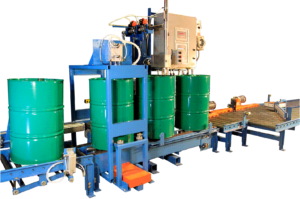Foam Reduction Leads to Increased Production in Drum Fillers
The Customer
A major cleanings manufacturer needed a semi-automatic filler to fill 55 gallon drums with a foaming product. The idea was to keep an operator away from the filling station and to allow a steady pace of filled drums throughout a two-shift process. The rate was one drum every 75 seconds, because of foaming and high viscosity.
The Challenge
The customer had two additional problems that could not be met by other filling manufacturers they had already contacted. The filling system had to fit into a room with a 12’ ceiling. Since a large percentage of liquids were foaming products, a sub-surface filler was necessary. Typically a sub-surface filler requires 13’ ceiling clearance. The other condition was limited floor space for filled drums to accumulate prior to fork-truck pickup.
The Solution
Specialty Equipment solved the problem by providing the customer with a custom-made, semi-automatic filler that would max out at slightly less than
The Customization
The operation was designed as a straight-line configuration where empty drums, with bungs previously removed, accumulated to an air-operated escapement. When a drum was called, the escapement retracts and an air-operated bar drops down between the first and second drum, pulling the drum into the rotator station.
Every drum is rotated to find and lock-in the bung position. Upon arrival, on a twin-strand chain conveyor, the drum is raised by four skewed rollers. A cradle of wheels and a powered pneumatic tire move into position on each side to capture and center the drum. The drum is automatically rotated while a sensor locates the bung.
After rotation, each drum is conveyed to the fill station then signals its arrival. The filler’s 1,000 lb. brick scale is raised between the chains, lifting the drum. A signal is then sent to start the fill cycle. An Allen Bradley PLC controller with touch screen, in a NEMA 4X nitrogen purged panel, was also part of the filler package.
The Benefit
A powered roller conveyor receives the filled drum at the bung station, outside the filling room. Upon discharge, each full drum conveys past a mechanical wig-wag diverter which sends drums onto twin gravity accumulation conveyors. Drums convey left then right then left and right, until fully accumulated. A fork truck picks up four drums at a time from the side of the accumulation line. All the equipment was built and tested at the Specialty Equipment plant in Houston, Texas.
